
In her latest cookbook, Salad for Days, the Good Food columnist lets us into the secrets of making friends with salads.

The notion that you don’t win friends with salad has haunted me ever since Homer Simpson used this fateful line in an episode about Lisa going vegetarian. It became a chant, then a meme, and it’s been echoing in my ears for decades. Which may seem like no big deal, until you consider that the consumption rates of salad – and vegetables in general – are in dire straits.
True, the ’90s were not kind to salads. Limp lettuce, fat-free dressings, too many sun-dried tomatoes, it’s no wonder people weren’t lining up to give salads a rap.
No longer a bowl of leaves, Salad 2.0 can be just about anything you want it to be. Cooked or raw veg, greens, grains, carbs, nuts, seeds, cheese, fruit – bring it on.
So I put to you a new paradigm: you DO win friends with salad. Especially when you make them with these essential tips and tricks in mind.
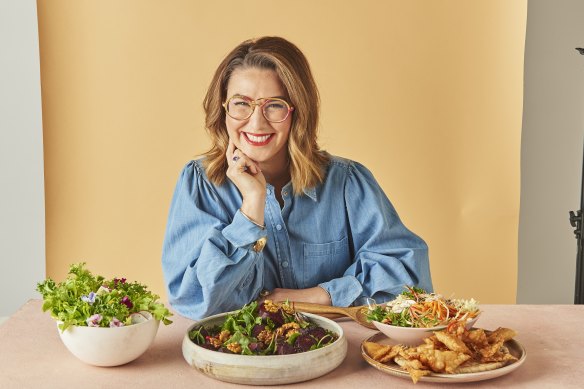
Seasoned professional
When a recipe says “season to taste”, the “to taste” bit usually refers to salt because there’s a remarkable variation in the saltiness of salts available. So it pays to pay attention to the type of salt recommended – particularly in a recipe where it’s used with relatively few other ingredients, such as salads.
I use salt flakes in my recipes, but even flaky salt can vary, so don’t take my word for it – taste the dressing and correct it if needed. My favourite salt is a pink lake salt from Down Under, but anything flaky, where the jaggy surface area shimmers across the finished product like snowflakes, is the direction to take.
If you have fine table salt, quarter the salt amount given and taste judiciously. Do consider investing in flaky salt if you can (online retailers will often run sales on products like this, which is a handy time to stock up because salt won’t go off); it makes a massive difference to the end result – not just to the flavour but also visually and texturally – and is one of the bigger bang-for-buck swaps you can make.
Crack on
Some spices you can get away with buying pre-ground, but black pepper isn’t one of them. Grinding peppercorns to order is a revelation, not only for the fizzy tingle but also the floral aroma, which will make you sneeze if you whiff too close. I think it adds to pepper’s intoxicating appeal. If a recipe gives you a measurement, pop the base of the grinder into your palm and crack the pepper in, then syphon into a measuring spoon to measure. A quarter of a teaspoon is plenty for a dressing for 4-6.
Oil you need is love
I’m gonna let you in on a little secret. Pretty much any salad can easily be dressed with extra virgin olive oil and a bit of salt and pepper. Extra virgin olive oils labelled “fruity” or “mild” are best for dressings, as they’ll meld with the rest of the ingredients rather than dominating. I do like to splash out (pun intended) on a small bottle of something more herbaceous and bitter for occasional “finishing” (this is when you grab the bottle in your hand, hold it over the salad and give it one last flick of the wrist for dramatic effect, like you’re Jackson Pollock).
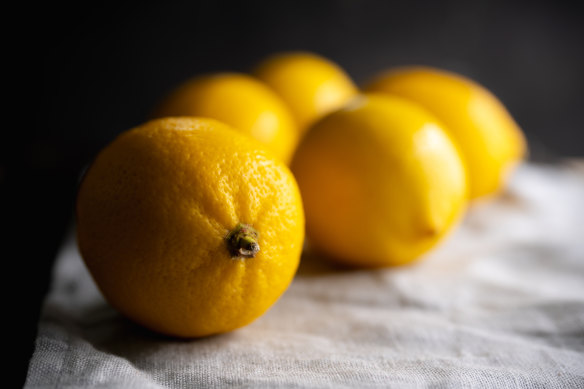
Acid trip
When balancing a dressing, or looking for that je ne sais quoi in a salad, the answer is probably “acid”. Whether that’s a squirt of citrus or a splash of vinegar, this is the element that cuts through richness and leaves your mouth puckering and poised for another bite. You really can’t go past lemons for a cheap and cheerful kick of sourness.
Don’t forget to zest the lemon before you juice it, and consider using the peel for a more intense flavour. Limes are “saltier” than lemons, so swapping one for one requires adjusting the seasoning a little. One lemon usually contains 3-4 tablespoons of juice, while a lime contains about half that. For maximum juiceage, roll your lemon or lime across the bench or zap for 20 seconds in the microwave before juicing.
A white wine vinegar is the simplest and purest acid but can be a little sharp, depending on the brand. Buy the best you can afford because the cost is reflective of time in the barrel. If you’re on a budget, fake the barrel time with a pinch of sugar and five minutes of supervised bubbling on the stove to reduce and intensify, or by adding a little honey or maple syrup into the dressing if it’s not already there. And, as always, taste, taste, taste.
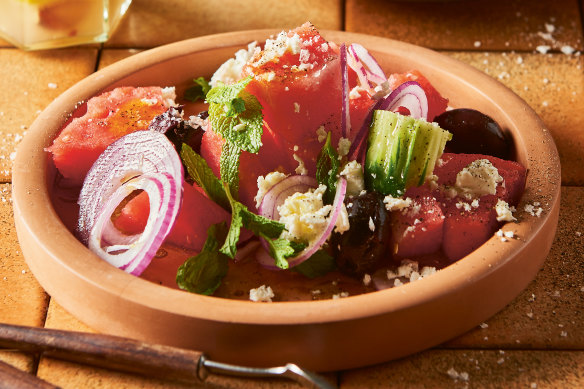
Always add an allium
As far as I’m concerned, a salad needs some amount of allium to round out the flavour, whether that’s a white salad onion for the mildest hit, a Spanish red for its colour and sweetness, or a bog-standard brown for zing. Spring onion (the long green one) is easy to slice and scatter, with a mellow, syrupy flavour. Shallots (eschalots) are somewhere between spring onion and onion proper in flavour, and I particularly like the way adding acid to them makes them blush.
Hit refresh
As the great philosopher Derek Zoolander once said: “Moisture is the essence of wetness, and wetness is the essence of beauty.” As soon as produce is picked, it starts to lose moisture, exacerbated further by transportation, handling and the arctic aridness of refrigeration.
But all is not lost! The more porous your veg, the easier it is to reinvigorate. Send lacklustre lettuce and crusty celery to the day-spa in the form of a dip in a bowl of water, the colder the better.
“Refreshing”, as it’s technically called, is also excellent for creating curly spring onion slices, crisping up radish and fennel, and giving soft herbs an extra spring in the frond. If you’re in a hurry, ice cubes to chill the water will accelerate the effect.
Spin it to win it
If you want to eat more salad, get a salad spinner. I know I’ve just told you to hydrate your herbiage, but if you don’t dry off the exterior when ready to use, the dressing’s just going to slip right off. It may feel like just an extra gadget, but I use my salad spinner to save time because it’s so easy to soak, drain and spin all in the same vessel.
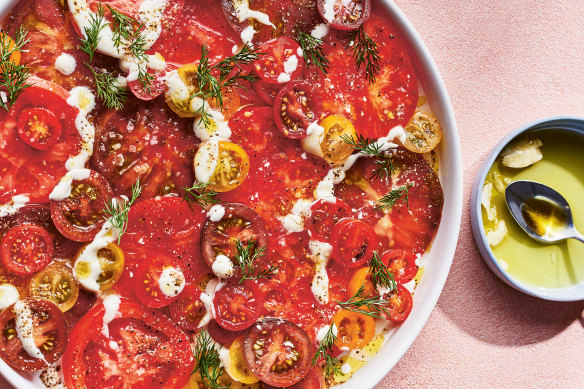
A cut above
Here’s a rule of thumb worth remembering: the smaller your slices, the shorter to table time. What that means is that if you’re serving the salad right away, and not planning on leftovers, cut the veg smaller for the dressing to permeate quickest. Ergo, if you’re travelling a distance, chunkier shapes will hold better.
One sharp chef’s knife is best for cutting the veg, along with a serrated paring knife for smaller tasks and chopping tomatoes. If your knife skills are a work in progress, outsource: use a food processor or mandolin for slicing your coleslaws (watch fingers!) and grab a julienne peeler for thinly slicing veg like zucchini or carrots.
Tossing with caution
If you’ve ever looked at a schmicko restaurant salad and wondered how they managed to dress it so evenly and serve it without a smidgen of schmear, it’s time to start double bowling. Toss your salad in a large bowl (the bigger the better) then turn it out onto a serving platter or clean bowl to serve. A good pair of tongs (silicone-tipped, spring-loaded) will help if you’re not adept at the flick-n-toss, and will ensure that you get right down to the bottom, like you’re turning compost.
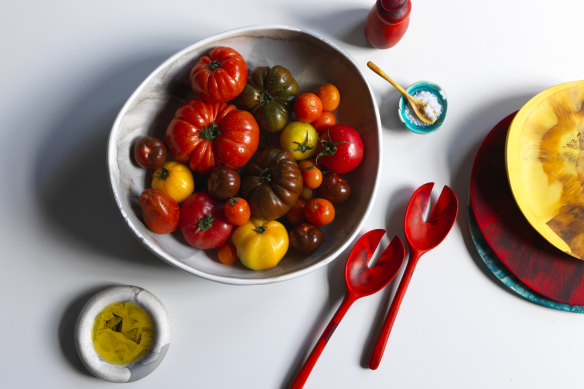
Bowls and platters
To up your salad-serving game, invest in some beautiful bowls and platters. No need to break the bank – thrift shops and flea markets are your best friends, because big bulky bowls are the first to hit the deck when people decide to Spark Joy. If creating a new serving-ware wardrobe, choose a colourway, then stick to the family, whether that’s broody darks that make bright veg pop, muted neutrals or bright whites. When choosing whether something needs a bowl or a platter, think about the way you want your diners to see the salad – if it’s a vertical job that looks best from the side, then platter up! If it’s extra juicy, or needs more tossing at the table, give yourself some higher sides to keep the table from wearing more than it bargained for.
The best recipes from Australia's leading chefs straight to your inbox.
Sign up


























